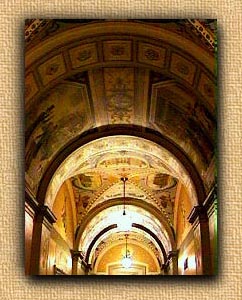About the Mural
The Mural
The Cox Mural in the Capitol: In the late 1960s, the National Society of the Daughters of the American Revolution and the United States Capitol Historical Society jointly sponsored a project to foster a greater awareness and appreciation of our nation’s past by recording the American story on the walls of the United States Capitol. Allyn Cox, who had completed the Rotunda friezes begun by Constantino Brumidi in the 19th Century, was commissioned for the project.
Planning for the House wing murals began during the winter of 1969-70. After deciding to place them on the vaulted ceilings, Cox completed scale drawings of the proposed murals, making sure they were historically accurate and in harmony with the building’s architecture. He began the actual work on the ceilings in February 1973, with the “Hall of Capitols” series. Aided by Clifford Young, who helped work up the cartoons (preparatory drawings), he completed the series in July 1974.
This first phase of the project, funded by the U.S. Capitol Historical Society, tells the story of the Capitol and includes paintings of the 16 buildings in which Congress and its predecessors have met since 1754. Other panels contain scenes set in or around the halls of Congress and portraits of persons associated with the Capitol.
“New Dome Symbolizes Union”: One of the murals in the Hall of Capitols depicts Capitol Architect Thomas U. Walters showing his plans for the building’s new dome to President Abraham Lincoln. Cox used an 1863 photo of the dome under construction (attributed to famed Civil War photographer Matthew Brady) as the basis for the scene.
Construction on the dome, authorized by Congress in 1855, was interrupted by the Civil War, but began again in 1862 under Lincoln’s order that construction be continued as “a sign we intend the Union shall go on”. The last section of the “Freedom” statue atop the dome was put in place on December 2, 1863, at which time the U.S. flag was unfurled and a 35-gun salute (one for each state, north and south) was fired.

